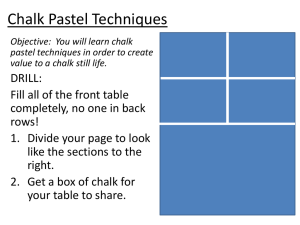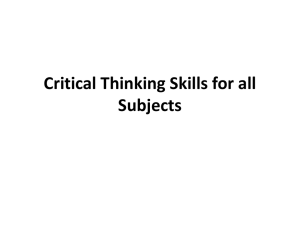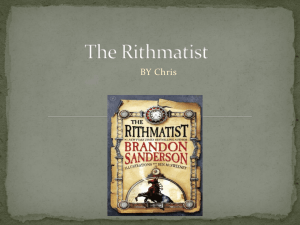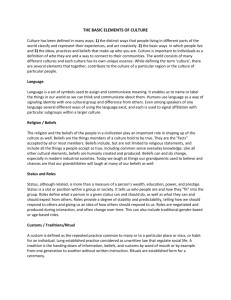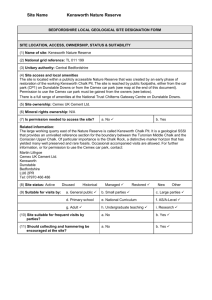School Culture Chalk Talk - John W. Gardner Center for Youth and
advertisement
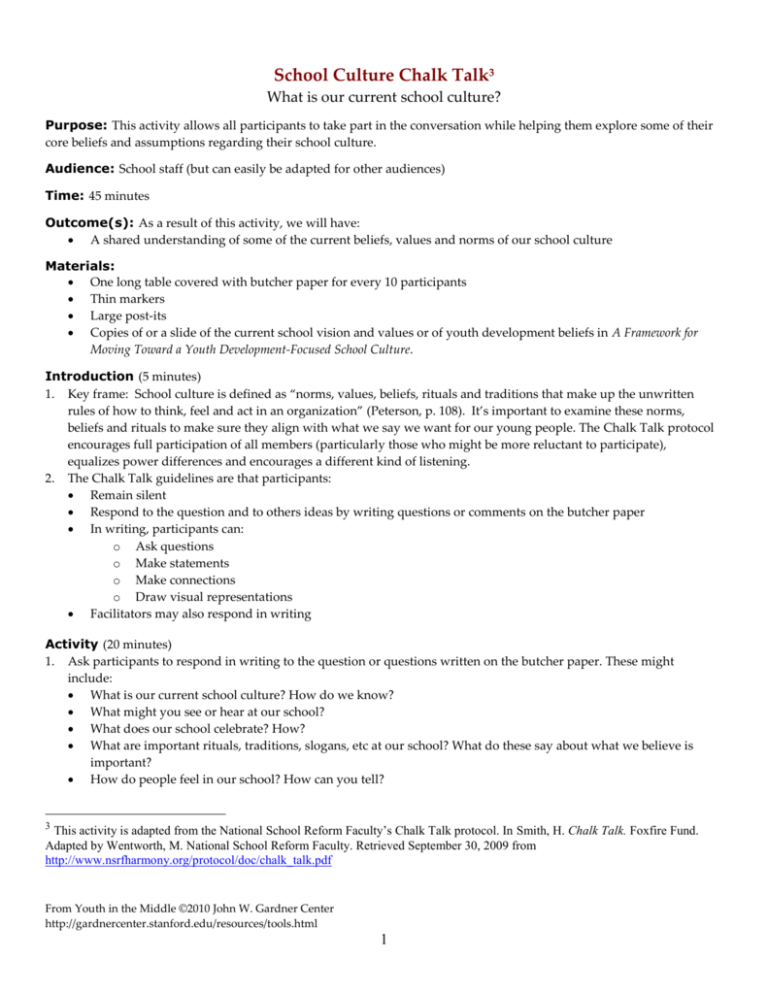
School Culture Chalk Talk3 What is our current school culture? Purpose: This activity allows all participants to take part in the conversation while helping them explore some of their core beliefs and assumptions regarding their school culture. Audience: School staff (but can easily be adapted for other audiences) Time: 45 minutes Outcome(s): As a result of this activity, we will have: A shared understanding of some of the current beliefs, values and norms of our school culture Materials: One long table covered with butcher paper for every 10 participants Thin markers Large post-its Copies of or a slide of the current school vision and values or of youth development beliefs in A Framework for Moving Toward a Youth Development-Focused School Culture. Introduction (5 minutes) 1. Key frame: School culture is defined as “norms, values, beliefs, rituals and traditions that make up the unwritten rules of how to think, feel and act in an organization” (Peterson, p. 108). It’s important to examine these norms, beliefs and rituals to make sure they align with what we say we want for our young people. The Chalk Talk protocol encourages full participation of all members (particularly those who might be more reluctant to participate), equalizes power differences and encourages a different kind of listening. 2. The Chalk Talk guidelines are that participants: Remain silent Respond to the question and to others ideas by writing questions or comments on the butcher paper In writing, participants can: o Ask questions o Make statements o Make connections o Draw visual representations Facilitators may also respond in writing Activity (20 minutes) 1. Ask participants to respond in writing to the question or questions written on the butcher paper. These might include: What is our current school culture? How do we know? What might you see or hear at our school? What does our school celebrate? How? What are important rituals, traditions, slogans, etc at our school? What do these say about what we believe is important? How do people feel in our school? How can you tell? 3 This activity is adapted from the National School Reform Faculty’s Chalk Talk protocol. In Smith, H. Chalk Talk. Foxfire Fund. Adapted by Wentworth, M. National School Reform Faculty. Retrieved September 30, 2009 from http://www.nsrfharmony.org/protocol/doc/chalk_talk.pdf From Youth in the Middle ©2010 John W. Gardner Center http://gardnercenter.stanford.edu/resources/tools.html 1 2. 3. Write questions or other responses to participants’ comments, particularly in terms of using data or evidence to draw conclusions or helping participants to link actions to underlying beliefs. These might include: How do you know? What evidence do you have of that? Given these practices, what seems to be important to your school? Given this action/statement, what seems to be the underlying belief that school members have? When it seems like the conversation is coming to completion, break the silence and ask participants to read what others have written. Closing (15 to 20 minutes) 1. Ask the group to share themes. What are some adjectives they would use to describe their current school culture? Write these on big post-its and stick them on the butcher paper. 2. Have the group compare their summary description of their school culture with their published school vision and values or with youth development values and beliefs. What do they notice about the alignment of their school culture with what they say is important to them? 3. What are some key next steps the group wants to take to continue this conversation with other school members? Facilitator Tips: This activity may surface sensitive issues in the school. Some members may become defensive. If this occurs, it’s important to help all group members to understand that the culture of a school is created by all school members and their external circumstances.. If a school culture is particularly negative or blaming of other school members, that is a symptom of underlying issues such as staff members who have exhausted all strategies, are not experiencing success, and are unsure of what to do next. It can also be symptomatic of the huge and very real pressures schools feel around high-stakes testing. Depending on the group, some school members may be eager to take action while others may be in denial or need to process their feelings of guilt. Whatever their response, the group needs to be given space and time and should be encouraged to take the time to continue the dialogue with other school members in a productive way. It may help them to identify key next steps that will allow them to continue the conversation by holding a climate meeting or a staff meeting to further address any issues that come up for them. Works Cited Peterson, Kent. D. Shaping School Culture: Excerpts from an Interview with Dr. Kent Peterson. Retrieved October 15, 2007 from http://www.smallschoolsproject.org. Smith, H. Chalk Talk. Foxfire Fund. Adapted by Wentworth, M. National School Reform Faculty. Retrieved September 30, 2009 from http://www.nsrfharmony.org/protocol/doc/chalk_talk.pdf From Youth in the Middle ©2010 John W. Gardner Center http://gardnercenter.stanford.edu/resources/tools.html 2 A Framework for Moving Toward a Youth Development-Focused School Culture This broad framework serves as a general goal of the overall work and captures what we believe are the essential features of a school that supports movement toward a youth development approach. From research on school change efforts, we know that for these efforts to be sustained, the school culture must be aligned with the underlying principles of the change effort, for “absent knowledge about why they are doing what they’re doing, implementation will be superficial only, and teachers will lack the understanding they will need to deepen their current practice or to sustain new practices in the face of changing contexts” (McLaughlin & Mitra, 2001). Therefore, this framework recognizes that the success of this change effort relies on the alignment of school members’ beliefs and actions with a youth development approach and that these beliefs and actions are influenced through: 1) A youth-centered vision and values, 2) Collaborative structures that allow school members to share perspectives and reflect on data in working toward this vision, and 3) School champions who work intentionally and persistently to support all school members in realizing this vision. School-Wide Systems that Sustain a Culture with… • A Youth-Centered Vision and Values (that are constantly reviewed/assessed and linked to actions) • Vocal Champions/Critical Mass (to lead and shape the work) • Collaborative Structures that support, reflective, data-driven conversations, shared decision-making and sharing of lessons learned with all school members Actions Beliefs All school members believe that all Positive youth (as well as all staff/families): Youth • Want to learn Outcomes: • Have valuable things to Social/emotional contribute well-being • Can grow/change/ learn Physical through effort & with support health/safety • Deserve to feel known, heard, Increased motivation cared about, respected, Increased/sustained appreciated to feel safe and learning ready to learn/work Critical thinking/ life skills • Are capable of: making to prepare youth healthy choices, driving their for success in own learning, taking high school & leadership roles, etc. beyond • Can handle responsibility (Effective youth development practices) so that every young person is afforded: • Meaningful skill-building experiences • Opportunities to support their autonomy In an environment in which they feel: • Cared for, welcome, known, respected capable and successful • Physically and emotionally safe Works Cited McLaughlin, M.W. & Mitra, D. (2001) Theory-Based Change and Change-Based Theory: Going Deeper, Going Broader. Journal of Educational Change, Vol. 2, 301-323. From Youth in the Middle ©2010 John W. Gardner Center http://gardnercenter.stanford.edu/resources/tools.html 3



